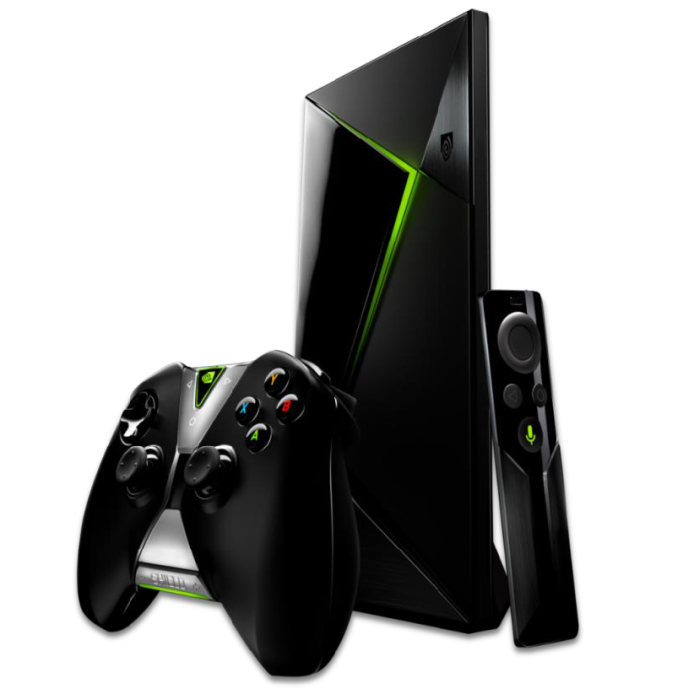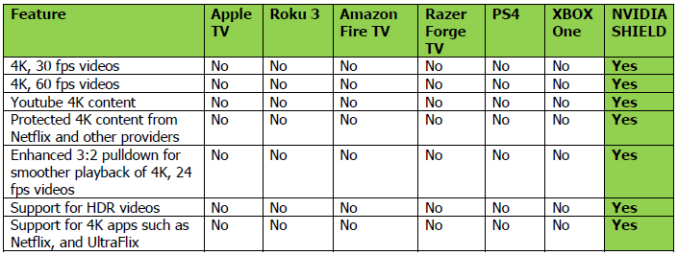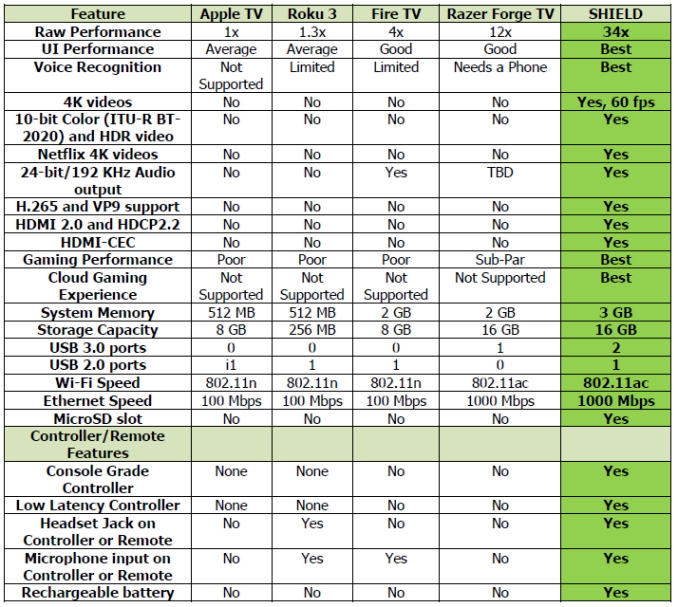The NVIDIA SHIELD Android TV Review: A Premium 4K Set Top Box
by Ganesh T S on May 28, 2015 3:00 PM EST- Posted in
- Media Streamer
- Home Theater
- TV
- 4K
- Shield
- NVIDIA

The battle for the living room (i.e, controlling the television experience) is heating up with forays from multiple vendors. As the cord-cutting trend gains momentum, the time seems to be right for disruption. Roku has been around for a long time and they continue to taste success with inexpensive and small over-the-top set-top boxes (OTT STBs). At the other end of the spectrum is the Apple TV, which, despite just being a 'hobby', has managed to move millions of units. Google had tried to make inroads into this market a few years back with the Google TV / Logitech Revue, but, it unfortunately didn't pan out as expected. Chromecast turned out to be more popular in their second attempt, but it was a limited play. In late 2014, Google launched Android TV along with the Nexus Player.
Coinciding with Google I/O, NVIDIA is releasing their previously announced SHIELD Android TV. First announed back in March at the 2015 Game Developers Conference, SHIELD Android TV is a premium 4K-capable over-the-top set-top box (OTT STB) with a powerful graphics engine. The differentiating aspects compared to the Intel Bay Trail-based Nexus Player and the Qualcomm Snapdragon-based Razer Forge TV lie in 4K support (HDMI 2.0 / HDCP 2.2 / Netflix 4K-certification) and excellent gaming credentials.
| NVIDIA SHIELD Family | ||
| NVIDIA SHIELD Tablet | NVIDIA SHIELD Android TV | |
| SoC | Tegra K1 (2.2 GHz 4x Cortex A15r3, Kepler 1 SMX GPU) | Tegra X1 (4x Cortex A57 + 4x Cortex A53, Maxwell 2 SMM GPU) |
| RAM | 2 GB LPDDR3-1866 | 3 GB LPDDR4-3200 |
| NAND | 16/32GB NAND + microSD | 16GB NAND + microSD + USB |
| Display | 8” 1920x1200 IPS LCD | N/A, HDMI 2.0 4Kp60 Output |
| Dimensions | 221 x 126 x 9.2mm, 390 grams | 210 x 130 x 25mm, 654 grams |
| Camera | 5MP rear camera, 1.4 µm pixels, 1/4" CMOS size. 5MP FFC | N/A |
| Battery | 5197 mAh, 3.8V chemistry (19.75 Whr) | N/A, 40W Power Adapter |
| OS | Android 5.0.1 | Android TV |
| Connectivity | 2x2 802.11a/b/g/n + BT 4.0, USB2.0, GPS/GLONASS, mini HDMI 1.4a | 2x2 802.11a/b/g/n/ac + BT 4.1/BLE, USB 3.0 + 2.0, HDMI 2.0 + HDCP 2.2, IR Receiver, Gigabit Ethernet |
| Launch Price | $299 (16GB/WiFi) + $59 (optional controller) | Basic: $199, Includes 1 SHIELD Controller Pro: $299, Adds 500GB Hard Drive |
The NVIDIA SHIELD smart TV platform comprises of three distinct products, the SHIELD console, the SHIELD wireless controller and the SHIELD remote.
The SHIELD is the main console, integrating a Tegra X1 SoC along with 3 GB of LPDDR4 DRAM and 16 GB of storage. I/O ports include two full-sized USB 3.0 host ports, a USB 2.0 micro-USB device port, GbE RJ-45 port, IR for universal remotes and 802.11ac 2x2 MIMO Wi-Fi with Bluetooth 2.1. It also includes a microSDXC slot. Video output is handled by a HDMI 2.0 port with HDCP 2.2 support.
The SHIELD Wireless Controller is the game controller bundled with the SHIELD console, and was first launched last year with the SHIELD Tablet. It uses Wi-Fi Direct for communication. A stereo headset jack and microphone are integrated. It also includes a rechargeable battery that can provide up to 40 hours of battery life.
Finally, the SHIELD Remote It is meant to be a replacement for the game controller in situations where single-handed operation is preferable. It uses Bluetooth for communication with the console. Like the game controller, a microphone and headset jack are included. The rechargeable battery is good for up to 4 weeks.
While the game controller and the console together retail in the basic package for $199, the SHIELD Remote is available separately for $50. Meanwhile after a slight snafu where it was announced back in April and then immediately pulled, NVIDIA is indeed offering a higher-end Pro SKU. SHIELD Pro model is similar to the SHIELD described above, except it adds an internal 500 GB hard drive into the mix and bundles a game - Borderlands: The Pre-Sequel! The Pro model is priced at $299.
Prior to diving into the details, let us take a look at the devices that NVIDIA is positioning the SHIELD Android TV against. Note that the two tables below are direct from NVIDIA's marketing material.
As we will see further down in the review, the above table is not far from the truth. In fact, except for NVIDIA claiming that their pulldown algorithm is enhanced compared to the competition, we tend to agree with everything. For the moment at least, NVIDIA pretty much has the 4K set top box to themselves.
NVIDIA claims a 34x raw performance increase compared to other OTT STB platforms. We won't endorse that particular number, but, in general, the performance of the SHIELD is miles ahead of the competition. The only other entry we find contentious is the availability of 24-bit / 192 KHz audio output. As we will see in the local media playback evaluation section, this is something of a moot point in most scenarios since the unit doesn't have licenses for decoding lossless HD audio. In any case, the above tables give an idea of where NVIDIA is positioning the SHIELD Android TV in the market.
The NVIDIA SHIELD Android TV also happens to be the first shipping product with the Tegra X1 SoC. We will first analyze the SoC and its performance in detail before moving on to Android TV in general and the SHIELD in particular.













167 Comments
View All Comments
BrokenCrayons - Friday, May 29, 2015 - link
Tablets with Windows 8.1 are very nice, inexpensive devices that can play videos and do a lot of other useful things, including running the usual library of x86 Windows software. While I think it's nice that nv is working on stuff like this, it just doesn't compete at all in flexibility with even something like a HP Stream desktop (the cute little blue tupperware-looking PC they sell for about the same price as this thing). Okay, okay, so you can display stuff on a 4k screen, but those aren't common and a lot of people, myself included, don't even own an external screen and would never consider buying one because they don't want to be stuck in one place passively consuming pre-recorded media. That seems like such an obsolete concept.Yojimbo - Friday, May 29, 2015 - link
You either have a lot of extra money or live alone. What happens to the TV when you take the tablet away? Why pay for a screen, camera, battery, and shock resistance, etc., or deal with power throttling when you don't have to? Any tablet that can do what the Shield TV can do is going to cost a lot more than the Shield TV. Plus the Shield TV doesn't look like someone left a tablet lying around. This is selling for $200 with a controller. The Shield Tablet cost $300 without a controller and with less I/O connectivity.savagemike - Friday, May 29, 2015 - link
It also won't toast bread - which my toaster does just fine. So I too don't see the point.TheJian - Friday, May 29, 2015 - link
Not sure why this can't replace your HTPC when you can load OTHER players that can do the things you call shortcomings of the built-in player (like kodi, VLC, Powerdvd's android app). It seems to me you should be able to get around any shortcomings with other apps.I see you said VLC doesn't work that well on shield right now (what do you mean by this comment ?), but what about running something like powerdvd from the PC as noted to get around issues? The android app will accept streaming from local PC's running PowerDVD which plays everything this won't I think. Most people even pondering an HTPC already have a full PC in another room on the network so any shortcomings here should be covered by that I'd guess (including playing blurays etc).
Why wasn't the Intel device shown in more stuff? IE, gfxbench, pcmark, Basemark 2? IE why not thrown in the surface 3 for these which you already have the scores for?
http://www.anandtech.com/show/9219/the-surface-3-r...
Saves me from bouncing back and forth to see how badly Intel got killed ;) You had surface 3 pro scores too as shown, why leave them out? Manhattan offscreen 1080p shows Surface 3 pro at 29fps, why not include it when you already have those scores? You had PCmark scores for Surface3 pro also shown above. Are the work portions completely different? Are the other pcmark tests not able to run on surface 3 pro? Photo editing/video playback etc PCMark benchmarks don't work on them? You had all the gfxbench scores for both surface3 pro and regular also. I don't get why you put them in for some stuff, but exclude listing those in other tests when you had the data.
daggre - Friday, May 29, 2015 - link
1. It's too expensive. It needs to be $99 like the Apple TV was before they dropped the price to $69. I know that's a huge drop and it may not be possible with the current specs (yet) but it won't ever be successful if it's more than $100.2. It needs to play all Android games, and then play Android TV games really really well. It may already do this but it wasn't clear from the article. Any games nVidia makes should be for Android TV in general (i.e. "Controllers instead of touch") but should really shine on Shield. If anyone plays a game on a different Android TV they should say to themselves "I wish I had bought a Shield" so then those games become both guides to other developers of what their Android TV games should be like, but also become advertisements to gamers on any Android device that the game they are playing on their phone/tablet/other Android TV hardware would be a better experience on the Shield.
In the end, if they don't have really good 3rd party support this will fail. Only Apple is capable of pulling a success out of the air (Apple TV) without 3rd party offerings, and even they had to open up to Netflix, Hulu, HBO and the sports channels.
malooka - Saturday, May 30, 2015 - link
The Matricom MX2 Midnight is about 79.00 You can get a fly mote (like a Wii remote) it has two partitions one side for internet and gaming and the other side for KODI They have a newer versioin out but I like my model which is a little cheaper. The xbmx which is now KODI is the streaming side. I love this box. You can find it on amazon. http://www.amazon.com/s/ref=nb_sb_ss_sc_7_14?url=s...bernstein - Friday, May 29, 2015 - link
Seems a bit like a missed opportunity...- no HD bitstreaming, no legacy hardware decoding...
- pairing a GTX960 class GPU (8 SMM instead of two) with an octo-core A57 might feasible for a $300-350 price point. Especially if it could dualboot steam os...
hifiaudio2 - Friday, May 29, 2015 - link
It is being said that Nvidia is considering a Codec pack to add HD audio passthrough, VC-1, Mpeg2, etc in hardware.It was also said that Mpeg2 hardware is already on the device, but currently only activated when installing a program like the forthcoming Silicondust HDHomerun DVR program that just had a Kickstarter and will come out in a few months (alpha testing to start in June for the Kickstarter backers).
Go the the Nvidia forums and voice your opinion for the Codec to be released!!!
https://forums.geforce.com/default/topic/836487/sh...
douglord - Friday, May 29, 2015 - link
GGames - You say this has 10-bit color output and HDR capability. Do any consumer grade dGPUs have that (along with the HDMI 2.0a and HDCP needs). I'm really concerned about this for my next PC build. Any thought on how to build a UHD Blueray capable 4k HTPC?ganeshts - Saturday, May 30, 2015 - link
GTX 960 is your only option right now.Wait for a few more months.. other options should start coming out